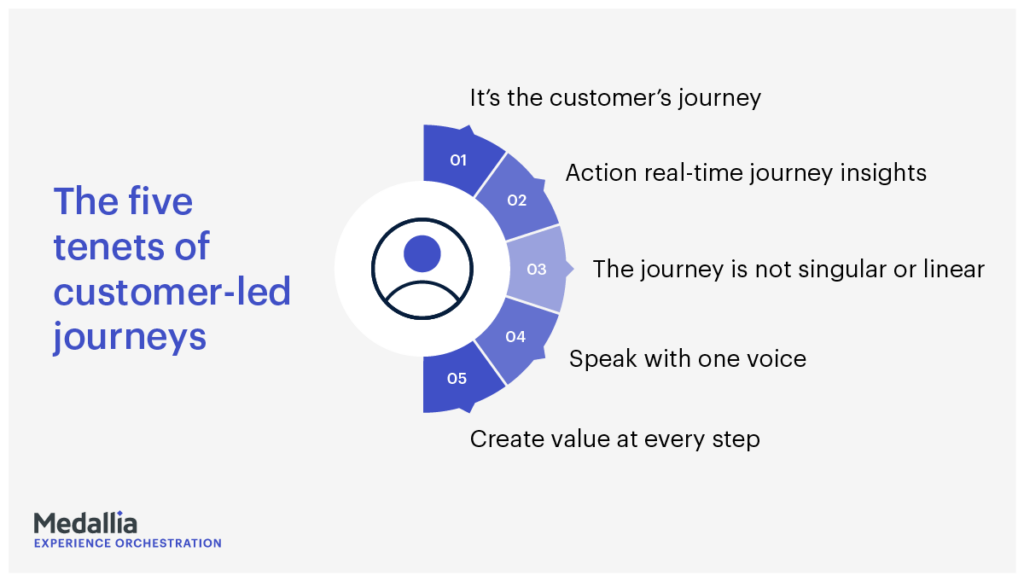What Is Customer Journey Management – and Why Is It Changing?
November 23, 2021
Customer Experience
With customer buying journeys evolving rapidly, it’s now more important than ever to understand how customer journey management achieves better business outcomes.
Considering we once relied predominantly on age or location as proxies for insight, the art of understanding customer behavior has become a rather complicated business. Organizations appreciate that everyone has personal interests, evolving intentions (with associated behavior) — and a unique relationship with them.
On top of this, the number of different paths each individual may take based on their specific needs (whether on a website, via a mobile app, contact center, or visiting the brand in person), means that it’s impossible to create an appropriate linear flow that everyone will follow. So, in the age of the connected consumer, the art of managing journeys for individuals at scale can soon feel overwhelming. Untangling these challenges to deliver a customer-first experience is the role of customer journey management.
Thankfully, in recent years, things have evolved dramatically.
What is Customer Journey Management?
Customer journey management is the oversight and orchestration of the different journeys that patrons take, wherever they take them. This requires us to understand the voice of the customer, identify key touchpoints that customers should hit when they’re interacting with us, and put measures in place to anticipate and manage the paths they take. For example, a brand may want to engineer a segment of a journey to ensure that someone signs up to a monthly newsletter after having a positive experience with the customer service team. The process needs effective managing to deliver the right message at the most opportune time.
Traditional journey management tends to put a brand at the center of every story. It is essentially engineering each journey to persuade people to do what we want them to, which isn’t necessarily conducive to their needs. Journeys become solely about our own process, rather than personalized experiences serving each individual’s goals.
Inconveniently, analyzing and managing a journey in this way doesn’t align with modern-day expectations for a customer-centric experience. Equally, customer analysis suffers from being delayed due to system limitations. Long story short, the moment to act – helping customers achieve their goals – has passed, and is often irrelevant.
Traditional customer journey management is essentially a form of dictating, creating a journey we want people to follow, to achieve the results we seek. It’s hardly a customer-centric approach in today’s customer-centric world. But with a reconfiguring of customer-managed journeys, times are changing…
Traditional Customer Journey Management vs the Customer-Managed Journey
Modern customer journeys are fluid across internal departments and myriad external channels, and far less predictable than we’d like. And with an ambition to empower customers, our accepted terminology – journey management – may itself be an unhelpful influence. After all, if an organization is managing, we set out with a potential implication that decisions are made in advance (effectively telling individuals where it wants them to go). But rest assured, it is possible to manage journeys that do actually start with the needs of individual customers.
Why does this matter? Clearly, two customers may seem near-identical on paper: they could be the same age, live in the same location, and even perform a similar job role. But in reality, their context (from their history with us to personal passions) and, crucially, their intentions may be worlds apart. Traditional customer journey management limits us since it can only take their general similarities into account and create each journey based on exploiting those. Even if the process is capable of using last-click information, this misses subtle, inferred preferences. For example, we may then provide only phone support, despite a general proclivity for online chat. And typically, the outcome of collective journeys is a linear experience bombarding everyone with the same message, regardless of what the customer may actually need at a given moment in time.
With customer-led journeys, directional, real-time behavioral data and journey insights are available and can be acted upon in the moment. Customer Journey Orchestration makes it possible to genuinely understand the needs of each unique customer and help them carve their own experience, from the platforms or channels they prefer to their recent experiences with the brand. The organization then becomes a guide rather than a manager, providing customers with a series of options at each touchpoint so they can make their own choices (rather than being squeezed into a process they aren’t ready for, or may be inappropriate).
None of this means that the traditional methods brands employ to manage customer journeys are obsolete. Far from it. But rather than being standalone monologues, customer-led journeys mean that campaigns and broadcasts become invitations to conversations that evolve and meander across a business. They also provide richer, more actionable insights that we can harness with Journey Analytics to create deeper relationships that evolve over time. The modern approach to managing the customer journey in a customer-led way, therefore, means handing over a degree of control. Able to act on intent, we can then consistently provide the best conversation for the very best end-to-end experience.
Handing Over Customer Journey Management to its Rightful Owner: The Customer
As the world becomes increasingly customer-centric, brands must better understand individuals at scale and the customer-led approach to journeys is becoming a norm.
If customer journeys are to start with the customer – based on their unique wants and needs, the onus is on brands to deliver value at every single interaction, ultimately providing mutual value.
Many businesses already place the customer journey at the center of their efforts to improve customer experience design. But in the age of the empowered customer, this may not be enough. It’s important to remember the limitations of a customer journey management framework: a brand shouldn’t fully manage its customers’ journeys. So, how can we hand over the management of customer journeys to the customers themselves?
Here are a few fundamentals of customer-led journeys:
1. Remember it’s the customer’s journey. And it’s very fluid.
It’s no longer appropriate (or necessary) to force a customer down a predetermined path. With so much available choice, they will simply go elsewhere if they’re not getting the experience they expect. An independent report that we have commissioned with My Customer found that out of the 200 service leaders we surveyed within the customer experience space, two-thirds felt that understanding customer journeys was more important now than 18 months ago.
Despite what we were led to believe, the customer journey isn’t a linear process like a sales funnel, so it can’t simply be engineered or optimized to achieve the result we want. While two customer journeys might look similar from afar, they might have a number of differences when analyzed at a granular level. Brands need to listen closely to events and customer feedback, meeting individuals where they are on their journey. We can then provide them with intelligent and relevant conversations; the right offers, support or information they need to take the next step.
2. Tap into real-time journey insights, and take action in the moment
Real-time data is invaluable for the customer and organization. A customer might well have called up support seeking to cancel their subscription, but if associated data isn’t digested and used immediately, it’s easy to make rookie mistakes like sending her a marketing email.
Real-time insights inform us of what’s working, and why people might be dropping off or going elsewhere at a particular point. They also tell us what matters most to our customer at any given moment in time. We can then take action to support them, whether that’s sending out a re-engagement campaign, providing customer support, or pausing a campaign in the midst of an ongoing service issue.
3. Understand that the journey is not singular – or linear
Customer journey maps often pick out one route that customers should take if everything goes to plan. In reality, things rarely do, especially given the myriad, complex and evolving needs of individuals at scale.
Add to this that every single customer can be on multiple journeys at the same time: they might be interested in more than one product; trying to get a refund; seeking support on financing or attempting to buy accessories. So, while journey simplification is tempting, it’s not particularly helpful.
4. As a brand, speak with one voice
While a company may interact with its customers across various divisions – say service, sales, deliveries, and marketing, the individual has little sympathy for inconsistencies or error: there is only one brand. But since many businesses operate divisively, their stakeholders reside at differing distances; from both the brand tone-of-voice, and the customer (with varying levels of empathy or context). We need to remember that the delivery of outstanding customer experiences requires us to speak with a single brand voice, supported by consistent and appropriate actions.
5. Create value at every step
Just because the customer is driving their own destiny, it doesn’t mean brands can’t create value within the journeys. People tend to ‘drop off’ if they’re not receiving the value they need, so we must consider each touchpoint to be a potential value exchange, and determine what customers might need from us in that exact moment.
Customer Journey Management at Scale
It makes sense that we need to dig into our customers on an individual level, but how can we do this at great scale?
The delivery of outstanding, customer-led experiences at scale requires brands to switch up their internal processes and adjust their metrics to support entire journeys, not just touchpoints or moments in time. This means new customer journey management software is needed – we can’t create an entirely new ecosystem around customer experiences by tweaking legacy tech. To support millions of customers across billions of interactions, we should be layering across systems with support from machine learning and AI.
There are three characteristics of the modern age of customer journey management:
- Actual: is your view of the customer journey ‘in-the-moment’, and based on what your customers actually do, in real time?
- Analysis: can your business use the actual customer journey data to provide insight that improves the way it meets customer needs?
- Actionable: does the journey data live in systems that enable you to take real-time action in response to live customer needs?
Customer journey management is no longer a case of initiating customer journey mapping or creating a pre-planned workflow. Instead, it’s about meeting people where they choose to reside, providing them with value when they need it, and helping them carve their own destiny.
Brands that optimize journeys to create end-to-end personalized experiences will be those driving truly customer-led growth. They will ultimately generate more revenue, improve customer satisfaction, and increase customer lifetime value.








